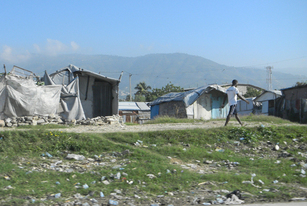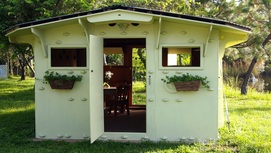
Disaster Shelter | Haiti Economic Conditions
Part 3 of a 5 part series
I’ve mentioned several ideas previously and introduced some concepts like the importance of cement in the Haitian economy. Let’s go a step farther. There are many in Haiti who don’t have enough to eat. This is mostly because they do not have a paying job. For the under-educated or the unfortunate there is sometimes agriculture but harvest is always too far away and the kids are hungry since yesterday.
I mentioned that limestone is everywhere underfoot. I have never seen so many rocks as I saw everywhere in Haiti. Limestone is fairly soft and the type found in Haiti is generally lightweight and very workable. Lets imagine that just three tools became available to anyone who wanted them, first, a rock hammer, second, a pair of plastic safety glasses and third, a simple gauge, to determine the standard size for a hand-chipped, limestone brick.
With these three things, costing probably no more than $20-30 US, anyone who wanted to, wherever they are, could go to work for themselves, in Haiti. It works like this:
Walk out to where the rocks are (almost anywhere in Haiti), pick up a likely stone, chip it till it’s the right length and fits through the standard brick gauge and bring it to a central collection point, located wherever they sell bags of cement. At the collection point your bricks are converted into cash and the chipper can convert the cash into a meal or anything else they need. The cement seller pays for and gathers bricks, stacking them on the same pallets the cement bags he sells were on. Remember when I mentioned one-way cement powder shipping? When the next otherwise empty cement-bag truck heads back to the dock, the (palletized) bricks are aboard. When the next otherwise empty (lighter) vessel returns to the ship in the bay, the bricks are aboard. When the ship returns to its home port, the bricks are aboard and become a commodity on the world market, a hand chipped, beautiful, limestone brick, imported from Haiti (at very little cost).
Some bricks will stay and be used in Haiti. We need not concern ourselves with that. A commodity always finds its best market. They can help to stretch that next bag of cement, and they are light colored and beautiful. Cement architecture always needs the help of a beautiful, hand-chipped brick to brighten it up a bit. Haiti can export a commodity (limestone) it has too much of. Anyone who wants work can hire themselves. Under-utilized resources are put to work. It’s a win-win situation for everyone. If I go to Home Depot to buy bricks, which would I choose: the squared-off factory-made cement one or the hand chipped limestone one at about the same price…Hmmm.
There are a few details that bear mentioning. Check back for Part 5 of my 5 Part Series on Disaster Shelter | Haiti Economic Conditions.
READ Part 1
READ Part 2
READ Part 3
READERS: What are your thoughts?
Part 3 of a 5 part series
I’ve mentioned several ideas previously and introduced some concepts like the importance of cement in the Haitian economy. Let’s go a step farther. There are many in Haiti who don’t have enough to eat. This is mostly because they do not have a paying job. For the under-educated or the unfortunate there is sometimes agriculture but harvest is always too far away and the kids are hungry since yesterday.
I mentioned that limestone is everywhere underfoot. I have never seen so many rocks as I saw everywhere in Haiti. Limestone is fairly soft and the type found in Haiti is generally lightweight and very workable. Lets imagine that just three tools became available to anyone who wanted them, first, a rock hammer, second, a pair of plastic safety glasses and third, a simple gauge, to determine the standard size for a hand-chipped, limestone brick.
With these three things, costing probably no more than $20-30 US, anyone who wanted to, wherever they are, could go to work for themselves, in Haiti. It works like this:
Walk out to where the rocks are (almost anywhere in Haiti), pick up a likely stone, chip it till it’s the right length and fits through the standard brick gauge and bring it to a central collection point, located wherever they sell bags of cement. At the collection point your bricks are converted into cash and the chipper can convert the cash into a meal or anything else they need. The cement seller pays for and gathers bricks, stacking them on the same pallets the cement bags he sells were on. Remember when I mentioned one-way cement powder shipping? When the next otherwise empty cement-bag truck heads back to the dock, the (palletized) bricks are aboard. When the next otherwise empty (lighter) vessel returns to the ship in the bay, the bricks are aboard. When the ship returns to its home port, the bricks are aboard and become a commodity on the world market, a hand chipped, beautiful, limestone brick, imported from Haiti (at very little cost).
Some bricks will stay and be used in Haiti. We need not concern ourselves with that. A commodity always finds its best market. They can help to stretch that next bag of cement, and they are light colored and beautiful. Cement architecture always needs the help of a beautiful, hand-chipped brick to brighten it up a bit. Haiti can export a commodity (limestone) it has too much of. Anyone who wants work can hire themselves. Under-utilized resources are put to work. It’s a win-win situation for everyone. If I go to Home Depot to buy bricks, which would I choose: the squared-off factory-made cement one or the hand chipped limestone one at about the same price…Hmmm.
There are a few details that bear mentioning. Check back for Part 5 of my 5 Part Series on Disaster Shelter | Haiti Economic Conditions.
READ Part 1
READ Part 2
READ Part 3
READERS: What are your thoughts?

About Shelter In A Day | Disaster Shelters
Winner of 2013 Aid and International Development Forum (AIDF) "Most Innovative Product Award." Shelter In A Day is the brainchild of eco-friendly, furniture designer Frank Schooley. Shelter's disaster recovery housing provides safe and secure, simple to construct, green homes for those displaced by natural disasters, such as hurricanes, earthquakes or floods.
The disaster shelters are a solidly constructed, termite, rust and rot resistant house, with lockable doors and windows. Homes are crafted from waterproof, recycled wood fiber material and can be easily erected anywhere, in one day.
Winner of 2013 Aid and International Development Forum (AIDF) "Most Innovative Product Award." Shelter In A Day is the brainchild of eco-friendly, furniture designer Frank Schooley. Shelter's disaster recovery housing provides safe and secure, simple to construct, green homes for those displaced by natural disasters, such as hurricanes, earthquakes or floods.
The disaster shelters are a solidly constructed, termite, rust and rot resistant house, with lockable doors and windows. Homes are crafted from waterproof, recycled wood fiber material and can be easily erected anywhere, in one day.
| | |
